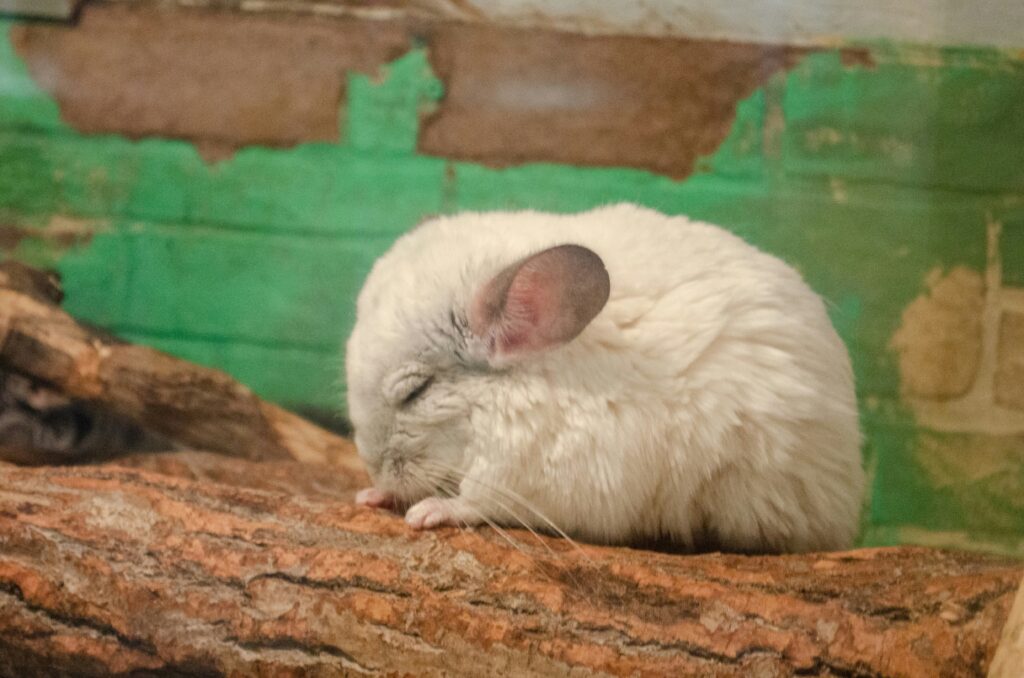All About Chinchilla Sleep

Chinchillas are adorable creatures known for their playful antics and lively personalities, but have you ever wondered about their sleeping habits?
In this guide, we’ll delve deep into the fascinating world of chinchilla sleep patterns, uncovering the mysteries of when, how, and why these fluffy rodents catch their z’s.
Understanding Chinchilla Sleep
Before we dive into the specifics of chinchilla sleep, it’s essential to understand the basics of how these adorable creatures rest. Chinchillas are crepuscular animals, meaning they are most active during the twilight hours of dawn and dusk.
In the wild, this behavior helps them avoid predators and take advantage of cooler temperatures.
While chinchillas do sleep, their sleep patterns differ from those of humans and many other animals, making them an intriguing subject of study for researchers and chinchilla enthusiasts alike.
The Circadian Rhythm of Chinchillas
Crepuscular Nature
As crepuscular animals, chinchillas are naturally inclined to be active during the early morning and late evening hours. This behavior is deeply ingrained in their biology and has evolved as a survival strategy to optimize foraging and social activities while minimizing exposure to predators.
Napping Throughout the Day
While chinchillas are most active during dawn and dusk, they also take periodic naps throughout the day. These short rest periods allow them to conserve energy and recharge between bouts of activity. Chinchillas may nap for brief periods of time, ranging from a few minutes to an hour or more, before resuming their explorations and play.
Adaptation to Captivity
In captivity, chinchillas may adjust their sleep patterns to accommodate their environment and daily routines. Factors such as lighting, noise levels, and interactions with humans and other pets can influence when and how often chinchillas sleep.
Providing a quiet, dimly lit environment during the day can help mimic their natural habitat and encourage restful sleep.
Observing Chinchilla Sleep Behavior
Sleeping Postures
Chinchillas exhibit a variety of sleeping postures, ranging from curled up in a ball to stretched out flat on their side. These positions may vary depending on factors such as temperature, comfort, and sense of security. Observing your chinchilla’s sleeping posture can provide insight into their overall well-being and comfort level.
Sleep Cycles
Chinchillas, like many mammals, experience multiple sleep cycles throughout the night. These cycles consist of alternating periods of light sleep (REM sleep) and deep sleep (non-REM sleep), during which the body undergoes restorative processes such as muscle repair and memory consolidation.
While the exact duration and composition of chinchilla sleep cycles are still being studied, researchers believe that chinchillas exhibit similar sleep patterns to other rodents.
Factors Influencing Chinchilla Sleep
Environmental Conditions
The sleep patterns of chinchillas can be influenced by various environmental factors, including temperature, humidity, lighting, and noise levels. Chinchillas prefer cool, dry environments with minimal light and noise disturbances, so it’s essential to provide them with a suitable habitat that meets their needs for restful sleep.
Social Interactions
Chinchillas are social animals that thrive on companionship and interaction with their human caregivers and fellow chinchillas. Positive social interactions during the day can contribute to a sense of security and well-being, promoting restful sleep at night. However, excessive noise or disruptions during the night may disrupt chinchilla sleep patterns and lead to sleep disturbances.
Health and Wellness
The health and wellness of a chinchilla can also impact their sleep patterns. Illness, injury, or stress may disrupt normal sleep behaviors and indicate underlying health issues that require attention. Monitoring your chinchilla’s sleep patterns and behavior can help identify potential health problems early and ensure they receive prompt veterinary care.
Tips for Promoting Restful Sleep in Chinchillas
Provide a Comfortable Sleeping Environment
Ensure your chinchilla’s cage is equipped with cozy bedding, hiding spots, and a quiet, dimly lit area for restful sleep. Avoid placing the cage in direct sunlight or near sources of heat or cold drafts that may disrupt sleep.
Maintain a Consistent Routine
Establishing a consistent daily routine can help regulate your chinchilla’s sleep-wake cycle and promote restful sleep. Stick to a regular feeding schedule, bedtime routine, and environment conditions to minimize disruptions and promote a sense of security.
Monitor for Signs of Distress
Pay attention to your chinchilla’s behavior and appearance for signs of distress or discomfort, such as restlessness, lethargy, or changes in appetite or grooming habits. These may indicate underlying health issues or environmental stressors that require attention.
Conclusion
Chinchillas are fascinating creatures with unique sleep patterns and behaviors that reflect their natural instincts and adaptations.
Understanding when and how chinchillas sleep can help chinchilla owners provide optimal care and create a comfortable, enriching environment for their furry companions.
By observing their sleep behavior, addressing environmental factors, and promoting positive interactions, chinchilla owners can ensure their pets enjoy restful, rejuvenating sleep and thrive in captivity!






